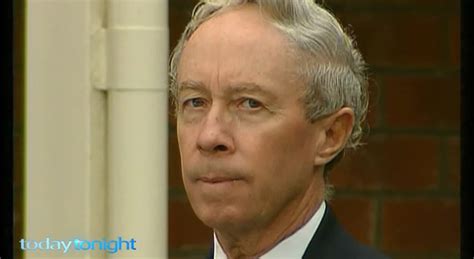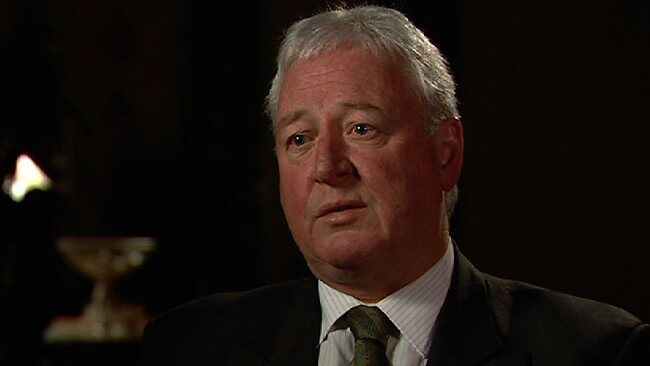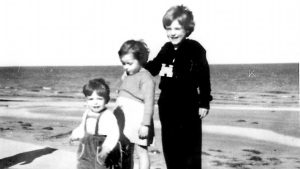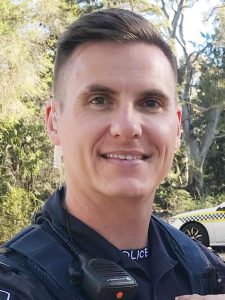The High-Profile Friends of Pedophile Magistrate Peter Liddy

The following article was authored by Hendrik Gout and appeared in The Independent Weekly in December 2008 (that publication has since been reincarnated as InDaily).
It describes the crimes of disgraced South Australian magistrate and serial pedophile, Peter Liddy, and the circumstances surrounding not only his defence and appeal but his prized estate. This disgusting human being counted police among his friends and had little trouble assembling a team of high-profile lawyers for his initial defence, the appeal of his conviction and even an attempt to block a civil damages claim by his victims. As the article notes, some of these lawyers are now District and Supreme Court judges.
One well-known friend and member of Liddy’s legal team was Eugene McGee, the regrettable human being who mowed down and killed innocent cyclist Ian Humphries on 30 November 2003 while driving eratically and at excessive speed. He then fled the scene and hid from police in what appeared to be a deliberate attempt to avoid a blood alcohol test (when finally apprehended over six hours after the killing, the arresting officers could still smell alcohol on McGee). This is the kind of behaviour that would have seen an ordinary citizen sent to jail, but McGee, a former police prosecutor, had many friends in the law enforcement and legal fraternity. Despite the seriousness of his crime, he received no jail sentence, was fined a mere $2,250 (a cyclist’s life is quite cheap in South Australia) and was disqualified from holding a driver’s licence for twelve months. The farcical Legal Practitioners Conduct Board (now the farcical Legal Profession Conduct Commissioner) refused to even suspend his legal license, ruling McGee was not guilty of “infamous conduct” and that he could continue to practise.
McGee currently practices as a criminal lawyer offering, among other things, representation for drink drivers. How truly perverse.
The Liddy files: Shamed and defamed
HENDRIK GOUT
20/12/2008
SA magistrate Peter Liddy was a serial pederast. He left a trail of broken lives and smashed reputations, but his strangest legacy is the story of a hundred lawyers, buried Spanish treasure and a TV producer who didn’t take yes for an answer. Hendrik Gout has the remarkable story.
Peter Liddy thought he’d got away with it. The respected magistrate was connected to power. He was power itself. He could – and did – send people to jail. He heard cases of all sorts – drunk driving, domestic violence, petty crime, dishonesty and embezzlement.
But for almost 30 years, Liddy also led a secret life. He liked fondling under-age boys. When not on the bench pronouncing others guilty or not guilty, Liddy was on the beach ruining innocent lives. He would go to the Brighton Surf Life Saving Club where he coached young lifesavers.
Then he would interfere with them sexually.
So Liddy was a practising criminal. Then, eight years ago, police came knocking, as eventually they must. Summons and warrants flew and Liddy did what most scoundrels do: he protested his complete innocence and resolved to clear himself of all the outrageous allegations.
Liddy assembled a top-flight defence crew, with solicitor Eugene McGee instructing Marie Shaw QC (who is now Her Honour Judge Shaw of the District Court). On the other side of the table, the prosecution side, sat Trish Kelly (later a QC and now Supreme Court Justice Patricia Kelly).

Cyclist-killer, pedophile-defender, former SAPOL prosecutor and still practising lawyer, Eugene McGee.
The horsehair was dusted off before Justice Margaret Nyland in Supreme Court of South Australia, and in April 2001 the trial began.
It was a salacious, month-long trial, gripping in its voyeurism. Witnesses came and went with lurid tales of abuse and defilement. The jury heard the evidence, and down went Liddy for 25 years – the longest sentence ever handed to a pedophile in SA and possibly in Australia.
Twenty-five years is also the length of time that Liddy had sat on the bench as a magistrate, another SA record, and while he was there he got rich. He bought himself a veritable mansion – a sprawling, late-Victorian former nunnery called Shenandoah at Kapunda, and he filled it with a bizarre collection of artifacts. There was booty from a Spanish galleon – there really was! Pieces of eight, jewels in rings, an ancient mariner’s telescope and pistol, a cutlass or two.
Having been under the ocean so long, the prized artifacts would disintegrate if exposed to air, so he kept them in an impressive fishtank of salt water in its own timber cabinet.
There was a room filled with 1500 miniature bottles which once held wine and spirits, and they were so valuable that not one bottle should accidentally fall. He had, or claimed to have, an internationally famous collection of early American firearms – muskets, flintlock rifles and pistols with their powder horns from the colonial period, Wild West revolvers and sheriffs’ badges, a brace of consecutive-numbered Colts and a document signed by the great George Washington himself.
Peter Liddy liked his lifestyle. He even wrote about it in magazines. He used a pseudonym and interviewed himself. It’s really wacky to read Liddy anonymously quoting Liddy in the Australian Shooters Journal. Then there’s this gem in the Australian Country Collector: ‘“Even the Legion of Honour medal of the soldier who once guarded the treasure was ultimately retrieved, as well as rings and other jewellery which made up the booty,’ explains Peter.”
Liddy felt very strongly, after his conviction, that he preferred the 14 main rooms of Shenandoah to the dismal cell in Yatala’s inhospitable G-division where he now spent 23 hours a day with an hour in the exercise yard. Inmates threatened his life. He had to be guarded by closed-circuit television. And he had a bit of time to think. He thought it would be a very good idea to launch an appeal and get his conviction overturned.
Meantime, though, Liddy’s victims were also mightily aggrieved. They’d been subjected to a type of torture, which is what child abuse is. Liddy tried to absent himself from court while the victims’ impact statements were being read, but in the end all he could avoid was their eye contact.
For the victims, it was not enough that Liddy be stripped of his reputation. They wanted revenge. They wanted financial recompense. They re-commenced legal action in the District Court for civil damages. Liddy had the dosh, and they wanted some of it.
So from his cell, Liddy had to fight this civil action. Again he hired Eugene McGee. McGee (now defending a charge of conspiracy for attempting to pervert the course of justice following the Kapunda Road Royal Commission) assigned two eminent barristers to help in the civil case.
They were Richard White QC (now a justice of the Supreme Court) and Rauf Soulio (now a judge of the District Court). Solicitor Noelle Hurley and barrister Simon Lane, the former Commissioner for Corporate Affairs, were retained to give advice in the civil case.
And so the treasure hunt began, though the victims had a nagging fear. “There is a thing called a mareva injunction,” lawyer Nick Iles explained last week from his Carrington Street office suite.
“If a person believes they have a claim on somebody’s assets, but it’s going to take a while for that claim to be sorted out in the court, the claimants can ask for an injunction – an order from the court that prevents the respondent from disposing of their assets.”
Nick Iles knows this case well. In the end, his involvement would be measured in units of hundreds of thousands, and those units would be dollars. So on June 14, 2001, Liddy’s victims sought just such an injunction, and they wanted it ex parte.
They feared that if Liddy knew that his assets were about to be frozen, the first thing he’d do would be to hide what he could of his considerable loot where it couldn’t be found. After all, the Spanish treasure had lain undiscovered for centuries before Liddy acquired it. Was there a need to mark the spot with a big X now?
There were eight victims seeking the mareva. Seven were represented by the firm Tindall Gask Bentley, which had Morry Bailes and Chris Branson in the chair; one victim hired Tom Byrne of Hume Taylor and Co. In they trooped before Judge David Smith of the District Court. Theirs was a convincing argument, but Judge Smith wasn’t convinced. He said Liddy ought to be told that momentous events were swirling and his assets were about to be iced.
Liddy got Eugene McGee onto the case. McGee had long been Liddy’s buddy. They were both lawyers. The Independent Weekly has seen McGee in an engrossing little home movie made by the Police Historic Society in 1993. (Liddy counted police among his friends.) The film shows a beaming Liddy giving awe-struck visitors a guided tour of Shenandoah’s immense collections.
At one stage, he holds up the personal seal of the judge who sentenced Ned Kelly to death. Lindy Powell QC acted for the victims, and on June 18, 2001, the judge heard pleas from both sides and then granted the mareva. The effect was to freeze Liddy’s assets – his super, reckoned to be three-quarters of a million dollars after tax, his mansion, his collections and any valuables or lesser baubles he may have metaphorically hidden under the bed.
Legal eagles fly high, and being birds of a feather their hourly rate together might make a Macquarie banker blush. Liddy had to pay his substantial legal bill and the mareva was later altered to allow these to be paid. In November 2001, Liddy applied for leave to appeal his conviction.
Prosecutor Wendy Abraham QC (now the Commonwealth Director of Public Prosecutions’ national in-house counsel) argued the sentence was appropriate and could even have been higher, though Justice Tom Gray granted leave to appeal. It was heard before three judges of the Supreme Court: Tom Gray himself, Ted Mullighan (who later headed a quite separate commission of inquiry into child sex abuse) and Tim Williams.
Their Honours did what honourable judges do, and despite vigorous argument by Eugene McGee’s team, assisted by Hurley instructing senior counsel David Peek QC, Liddy went back to the slammer.
The original mareva had four components. Liddy was not allowed to deal with, dispose of or move any of his assets. He would be allowed to pay for Shenandoah’s upkeep, including insurance, and he had to provide the plaintiffs – the victims – with a full list of his assets “in full particularity”.
Shenandoah was indeed a treasure trove, but how much was there in this Aladdin’s Cave? To open sesame, that was the question, and to answer that question they turned to a bloke called Eric Van Kruyssen. Van Kruyssen is now a solicitor with the Legal Services Commission in Port Adelaide but, in 2001, he was a less lofty lawyer and a friend of Peter Liddy.
Van Kruyssen offered his services, and his services were gratefully accepted. He would go out to the mansion, run his eye over whatever was to be run over, and provide a valuation.
There may have been one or two lawyers in Adelaide who weren’t involved in the Liddy case in some way, but it’s doubtful in a town where everyone knows someone and no-one is nowhere.
Even Bill “Wags” Morris joined the fun. Morris was a cop who wanted to do more than nab the bad guys. He took a law degree and in 2001 he could act on behalf of clients. Wags, as he was known to his friends, was Liddy’s mate and held his power of attorney.
Morris was never formally at the Bar Table during Liddy’s trial but he was in the court every day, even during the closed hearings. It was Morris (later appointed by Families Minister Jay Weatherill as counsel assisting the Mullighan Inquiry into the abuse of wards of the state, and in 2006 as magistrate by Attorney-General Michael Atkinson) who asked Van Kruyssen to drop in on Shenandoah and tally the treasure. Imagine the surprise when the valuation was well south of what some people believed to be true north.
“I do not pretend that this is a comprehensive list of items in the residence,” Van Kruyssen admitted. “I’ve not gone through all the cupboards, nor have I appraised each item minutely to establish authenticity.”
In fact, as he prepared Shenandoah and its contents for public auction, his catalogue and valuation excluded, without explanation, many of Liddy’s valuable shipwreck and American collectibles. The house was valued at $410,000 and the contents at a mere $90,000.
Meanwhile, back at the figurative ranch, Terry Stephens was having the time of someone else’s life. Stephens was a West Australian conman and convicted armed robber who found himself in Gawler in 2001, laying low and scheming schemes. His bravado got in the way of his common sense occasionally – he allowed a local newspaper, The Northern Argus, to claim he had a $16 billion fortune when Australia’s richest man, Kerry Packer, was worth a bagatelle $4.5 billion – but generally Stephens was happy simply defrauding for fun and profit.
Stephens didn’t have much of a clue, but he had the good fortune to employ a callow youth. The lad was the nephew of Peter Lewis, and Lewis was the most powerful man in South Australia. Lewis was Speaker of the House of Assembly and as such kept Labor in minority government and Mike Rann in the Premiership.
Stephens and Lewis met and got on like a house on fire, and that house was the mansion Shenandoah. Greedy men like Stephens are all alike, and they all like more than they have.
Stephens heard about Shenandoah coming up for auction. He thought the house and contents were a snap at half a million dollars, but equally there were 500,000 reasons why Stephens couldn’t scrape up the cash. He did what any sensible conman would do in those circumstances, and turned to those irascible financiers, the Gypsy Jokers.
The Jokers stumped up the money and Stephens had no doubt that while the interest was a bit steep at 120 per cent, all he had to do was move in, rummage under a floorboard or two, retrieve the buried treasure which he hoped could be worth up to $20 million, sell it without fuss, repay the bikies and settle down. It was so simple it couldn’t go wrong. Or could it?
Stephens turned the mansion downside up and outside in. The jewels were gone. Somebody had shot through with the guns. The treasures had vanished and there is no record of them having been there during the Van Kruyssen inspection, nor is the any suggestion that Van Kruyssen had seen them there. This wasn’t good news for Liddy’s victims, still trying to sue for damages in the civil court, but it was grim news indeed for the hapless Stephens, who owed Big Crime big time – the Gypsy Jokers do not enjoy a reputation for laughing off their losses.
Panicked, Stephens did the next thing any desperate and delusional conman would do in the circumstances – he publicly accused the Speaker of Parliament, Peter Lewis, of stealing the firearms.
Lewis had been involved in the flintlock saga. When Stephens thought he was going to find a hidden cache of antique guns at Shenandoah, a flash of genius told him he’d have trouble selling them with his criminal record. Lewis wrote a legitimate confidential letter to Police Minister Robert Brokenshire, asking for the minister’s help so the guns could be sold overseas.
Lewis later said he knew Stephens was a convicted felon but he did not know Stephens was a convicted armed robber. Brokenshire (now a Family First MLC) declined the request. Lewis denied stealing the guns. He sued Stephens and more lawyers joined the fray; it was quite a party.
Graham Archer has intelligent eyes and a brain that sees around corners, hands that have known hard labour and a lugubrious atmosphere that hangs from his lanky frame. He’s 59 years old, born in Victoria, raised in South Australia, an ex-factory worker who once galvanised Hills Hoists. He laid bricks until he realised he wanted to cement a stronger future for himself, so he went back to school, matriculated, enrolled at Flinders University, did an arts degree with honours, gathered a Diploma of Education and went teaching for 10 years.
The lad is multi-talented. In 1987 he joined Mike Willesee’s A Current Affair as a researcher and reporter before a two-year stint at the 7.30 Report. Sydney knocked; he answered. At Channel 9 he was supervising producer of the prestigious Sunday program, before he returned to Adelaide as producer of Channel 7’s Today Tonight.
Today Tonight is SA’s most enigmatic news and current affairs program. Fairy floss piled on dross, it has stories of dodgy used car salesmen, fad diets and medical breakthroughs that aren’t. Sandwiched in between those are the hardest-hitting, best-researched, best-filmed, best-told reports investigating South Australia’s own underbelly – solid investigative pieces which cut to the heart of the maladministration of justice in the state, stories of official corruption and chicanery, of rorts at government level, and of individuals duded by callous or indifferent officialdom.
Archer’s approach to commercial current affairs is pragmatic. He accepts that at 6.30pm on Channel 7, viewers don’t want a program that looks like Lateline or Four Corners. He knows that Today Tonight needs leavening to go with the long investigative pieces, and he doesn’t apologise for the more down-market segments if it means he’s got a huge audience for his substantive reports.
It’s a formula which obviously works. The program has won 312 of the past 312 consecutive surveys, unique in Australian television history. It is trouncing its opposition at Channel 9 and it has won Archer his peers’ accolades.
Today Tonight did its first Liddy piece after the former magistrate’s conviction, but its interest peaked when the paedophile’s victims sang songs of not getting their money. Where was their recompense, they asked? Archer tried to find out.
There is a particular African mammal called a ratel, a honey badger, the most fearless animal in the kingdom. A ratel will die rather than surrender. Once it bites it won’t let go. It will take on leopards and venomous snakes with belligerence and bravery in equal measure. You couldn’t keep one as a household pet, but if you did you could call him Graham.
Today Tonight was now on the case with ratel-like tenacity. It broadcast a story on June 10, 2002, which said Liddy’s victims couldn’t get their money because it had seemingly disappeared in legal fees. It questioned whether Liddy’s mansion and treasure had been sold too cheaply. Liddy’s lawyers were aghast. To them, the story seemed to imply that they had knowingly undervalued Liddy’s assets – which would amount to misleading the court – and that they’d put payment of their own fees improperly ahead of other considerations. The program did not name a single lawyer, but Michael Sykes of Sykes Bidstrup, acting for David Peek, Lynch Meyer acting for McGee and Shaw, and Nick Iles acting for Lane and Hurley all wrote to Channel 7 within the week, demanding an apology.
In legal parlance, Archer’s lawyers, Kelly and Co, replied that they had nothing to apologise for. In fact, Seven did more stories, and then more still, asking why Liddy’s victims had been robbed. One ripper yarn had Speaker Lewis saying that if the government didn’t hold a royal commission into the affair he’d withdraw his support for Labor and the government could come crashing down.
“Are you really willing to risk government to achieve a royal commission?” Lewis is asked on camera. “Dissolve the Parliament if necessary, yes,” answers Lewis. You could hear hearts pounding on North Terrace as the story went to air. The Liddy thing was completely out of control, it seemed to a panicked government. The damned thing had broken out of the courtroom and into the cabinet room.
Desperate to avoid being sacked and equally desperate to avoid a royal commission, the government called in solicitor-general Brad Selway QC to investigate and appease the erratic Lewis. Selway had been used in this capacity by a previous government. Liberal Premier John Olsen had asked the solicitor-general to investigate the government’s handling of an allegedly dodgy telecommunications contract, and Selway’s subsequent report gave Olsen the all clear.
Selway, who died suddenly and unexpectedly in 2005, admitted that he gave government the report it wanted (a later, more independent report by Dean Clayton QC forced Olsen out of office). Now Selway’s Liddy report gave the Labor government similar comfort.
On August 13, 2002, Attorney- General Michael Atkinson had every reason to be pleased as he rose to deliver a ministerial statement to parliament. Atkinson was finally able to stick the knife into his nemesis, Graham Archer.
Atkinson’s long-running duel with Today Tonight and its relentless, crusading producer was legend. Atkinson refused to release the Selway report but he summarised it by saying nothing was amiss, there’d been no impropriety on anyone’s part and – this was the A-G’s favourite bit – Archer was wrong.
Today Tonight responded by doing another story. On August 16 it broadcast a story dumping on the Selway report, supporting Liddy’s victims, criticising their lawyers and slamming the injustice of the justice system.
Liddy’s lawyers had given up asking for an apology. They sued for defamation. So off to the Supreme Court everyone trotted. Kelly and Co’s Peter Campbell and Belinda Grant, instructing variously Andrew Harris QC, Tom Blackburn SC, Kieran Smark SC and Sam Doyle, represented Channel 7. Nick Iles from Iles Selley, instructing Darrell Trim QC and Henry Heuzenroeder, acted for Lane and Hurley.
First there was the hiccup of finding a Supreme Court judge who could hear a case which pretty much involved pretty much every lawyer in town. Where was one to find an impartial judge?
The government searched and was even prepared to temporarily swear in a NSW judge to the SA bench for the trial, such was the level of angst. Eventually the Hon Bruce Lander, a judge of the Federal Court, was made an acting justice of the Supreme Court for the duration.
And what a duration to endure. Back and forth the case swung, from hearing to hearing, as the years rolled on and the legal costs mounted. Convinced that aspects of the Selway report were wrong, Today Tonight stuck to its guns. In fact, it went chasing them.
In 2005, after a three-year search by two specially trained investigators hired by the program, Archer reported that he’d found the missing cache of flintlocks in Melbourne. Then he got the pistols. There they were, laid out on a table as he did the interview. He’d done what the police couldn’t – he tracked down part of the fortune.
By any account, it was great TV. But for real drama, the courtroom was the place to be. Three weeks ago, on December 4, after a six-year battle, came the judgement. Lane and Hurley had won. They’d been legally vindicated. Lane was awarded $180,000, Hurley $130,000. More expensive for Seven was the order – agreed to by both parties – that Today Tonight pay Lane and Hurley’s legal costs, which could be three-quarters of a million dollars. Nick Iles, who’s worked on the case since its beginning, will finally get paid.
“We want to acknowledge the extraordinarily generous support we have had from the legal firm
of Iles Selley and our two barristers,” Simon Lane said after the judgment. “Without their support we could not possibly have taken on Channel 7.” Seven will also have its own legal costs, which might be as high as a $1.5 million. Kelly and Co aren’t cheap.
Lane and Hurley won, but who lost? Certainly Seven is down for the cash count, though Today Tonight’s reputation has hardly been shipwrecked. Archer’s network stood by him throughout the trial and he’s still Today Tonight’s top-gun producer.
His target was never Lane and Hurley, who were not mentioned by name in any broadcast. His target was broader, wider. It was a legal system, a system that sees a prominent magistrate guiltyof six counts of unlawful sexual intercourse, three of indecent assault and one of offering an inducement to withhold or give false evidence, and the victims denied adequate compensation.
Archer’s story centred on that premise: that justice is not just. Who lost? For at least a decade and probably longer, Peter Liddy, that urbane millionaire and raconteur, that well-connected judicial officer and collector of past histories, grossly defiled young men’s innocence.
Not all their names are known, and not all those names can be said aloud – even now, some are suppressed. But they know who they are, and the story of Liddy will always, always be about them.



What an absolute hive of scum and villainy!
Bloody hell!! This needs to be a book.
What an unbelievable tale. I wonder if Liddy was the next reincarnation of “the family” that terrorised Adelaide in the mid to late 70’s.